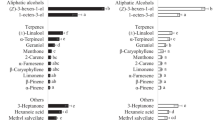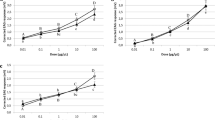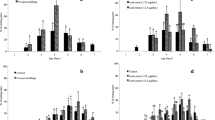Abstract
The codling moth (Cydia pomonella L.) is a significant pest of pome fruit throughout the world. Behavioral and ovicidal activities of five non-host plant extracts (Arctium lappa, Bifora radians, Humulus lupulus, Verbascum songaricum, Xanthium strumarium), synthetic sex pheromone, (E,E)-8,10-dodecadienol (codlemone), and the plant volatile lure, (2E,4Z)-2,4-decadienoate (pear ester) were evaluated against the codling moth, C. pomonella L. Codlemone elicited the greatest electroantennogram (EAG) response (6.2 ± 1.2 mV) of the compounds tested from male C. pomonella while pear ester elicited 1.7 ± 0.1 mV EAG response in female moths. Codlemone attracted 34.5% of male C. pomonella in olfactometer studies, and it was followed by the X. strumarium extract with 24.8%. There was a significant difference between the behavior of unmated and mated females. V. songaricum extract was the most active extract, attracting 25.4% of unmated females. However, mated C. pomonella females exhibited greatest attraction to pear ester. In a wind tunnel bioassay, combining X. strumarium with codlemone significantly increased the response of male upwind flight and source contact as compared with codlemone alone. All plant extracts, except for V. songaricum, significantly reduced the number of eggs laid. The plant extracts exhibited some toxic effects to eggs, and hatching rate of eggs was reduced as compared with the control. Our results indicate that some of the plant extracts tested are potential candidates for practical use after elucidation and characterization of active compound(s).





Similar content being viewed by others
References
Badgujar KB, Kasar SS, Nemade NV (2011) Repellent and antifeedant activity of methanolic extract and alkaloidal fraction of Sphaeranthus indicus in stored grain pests Tribolium castaneum (Herbst). Res Artic Budding Res 2:23–26
Beers EH, Brunner JF, Willett MJ, Warner GM (eds) (1993) Orchard pest management. Good Fruit Grower, Yakima
Bender DA, Morrison WP, Frisbie RE (1999) Intercropping cabbage and Indian mustard for potential control of Lepidopterous and other insects. HortScience 34:275–279
Cook SM, Khan ZR, Pickett JA (2007) The use of push–pull strategies in integrated pest management. Annu Rev Entomol 52:375–400
Croft BA, Reidl HW (1992) Chemical control and resistance to insecticides of codling moth. In: van der Geest LPS, Evenhuis HH (eds) World crop pests. Tortricid pests: their biology, natural enemies, and control, vol 5. Elsevier, Amsterdam, pp 371–387
Doughlas ML, Knight A (2005) Specificity of codling moth (Lepidoptera: Tortricidae) for the host plant kairomone, ethyl (2E,4Z)-2,4-decadienoate: field bioassays with pome fruit volatiles, analogue, and isomeric compounds. J Agric Food Chem 53:4046–4053
Dunley JE, Welter SC (2000) Correlated insecticide cross-resistance in azinphosmethyle resistant codling moth (Lepidoptera: Tortricidae). J Econ Entomol 93:955–962
Gökçe A, Stelinski LL, Whalon ME (2005) Behavioral and electrophysiological responses of leafroller moths to selected plant extracts. Environ Entomol 34:1426–1432
Gökçe A, Stelinski LL, Isaacs R, Whalon ME (2006) Behavioural and electrophysiological responses of grape berry moth (Lep: Tortricidae) to selected plant extracts. J Appl Entomol 130:509–514
Gökçe A, Stelinski LL, Whalon ME, Gut LJ (2010) Toxicity and antifeedant activity of selected plant extracts against larval obliquebanded leafroller, Choristoneura rosaceana (Harris). Open Entomol J 4:18–24
Han T, Zhang LH, Zheng H, Qin L (2006) New thiazinediones and other components from Xanthium strumarium. Chem Nat Compd 42:567–570
Kamboj A, Saluja AK (2010) Phytopharmacological review of Xanthium strumarium L. (Cocklebur). Int J Green Pharm 4:129–139
Knight AL (2008) Codling moth areawide IPM. In: Koul O, Cupernus G, Elliott N (eds) Areawide pest management theory and implementation. CAB International, Oxfordshire, pp 159–190
Knight AL, Brunner JF, Alston D (1994) Survey of azinphosmethyl resistance in codling moth in Washington and Utah. J Econ Entomol 87:285–292
Knight AL, Hilton R, Light DM (2005) Monitoring codling moth (Lepidoptera:Tortricidae) in apple with blends of ethyl (E,Z)-2,4-decadienoate and codlemone. J Environ Entomol 34:598–603
Knight AL, Stelinski LL, Hebert V, Gut L, Light D, Brunner J (2012) Evaluation of novel semiochemical dispenser simultaneously releasing pear ester and sex pheromone for mating disruption of codling moth (Lepidoptera:Tortricidae). J Appl Entomol 136:79–86
Landolt PJ, Guedot C (2008) Field attraction of codling moths (Lepidoptera: Tortricidae) to apple and pear fruit, and quantitation of kairomones from attractive fruit. Ann Entomol Soc Am 101:675–681
Light DM, Knight AL (2011) Microencapsulated pear ester enhances insecticide efficacy in walnuts for codling moth (Lepidoptera: Tortricidae) and navel orangeworm (Lepidoptera: Pyralidae). J Econ Entomol 104:1309–1315
Light DM, Flath RA, Buttery RG, Zalom FG, Rice RE, Dickens JC, Jang EB (1993) Host-plant green-leaf volatiles synergize the synthetic sex pheromones of the corn earworm and codling moth (Lepidoptera). Chemoecology 4:145–152
Light DM, Knight AL, Henrick CA, Rajapaska D, Lingren B, Dickens JC, Reynolds KM, Buttery RG, Merrill G, Campbell BC (2001) A pear derived kairomone with pheromonal potency that attracts male and female codling moth, Cydia pomonella (L.). Naturwissenschaften 88:339–342
Mantey KD, White LD (1975) Removal of intact female reproductive organs from codling moths. Entomol Exp Appl 18:393–394
McKenzie JD, Goldman R (2005) The student guide to MINITAB release 14. Pearson Education, Boston
Mitchell VJ, Manning LA, Cole L, Suckling DM, El-Sayed AM (2008) Efficacy of the pear ester as a monitoring tool for codling moth, Cydia pomonella (Lepidoptera: Tortricidae) in New Zealand apple orchards. Pest Manag Sci 64:209–214
Mota-Sanchez D, Wise JC, Poppen RV, Gut LJ, Hollingworth RM (2008) Resistance of codling moth, Cydia pomonella (L.) (Lepidoptera: Tortricidae), larvae in Michigan to insecticides with different modes of action and the impact on field residual activity. Pest Manag Sci 64:881–890
Peterson DM (1965) A quick method for sex determination of codling moth pupae. J Econ Entomol 58:576
Pinero JC, Dorn S (2007) Synergism between aromatic compounds and green leaf volatiles derived from the host plant underlies female attraction in the oriental fruit moth. Entomol Exp Appl 125:185–194
Reuveny H, Cohen E (2004) Resistance of the codling moth, Cydia pomonella (L.) (Lepedoptera:Tortricidae) to pesticides in Israel. J Appl Entomol 128:645–651
Schmera D, Guerin PM (2012) Plant volatile compounds shorten reaction time and enhance attraction of the codling moth (Cydia pomonella) to codlemone. Pest Manag Sci 68:454–461
Schmidt S, Tomasi C, Pasqualini E, Ioriatti C (2008) The biological efficacy of pear ester on the activity of granulosis virus for codling moth. J Pest Sci 81:29–34
Stara J, Kocourek F (2007) Insecticidal resistance and cross-resistance in populations of Cydia pomonella (Lepidoptera: Tortricidae) in Central Europe. J Econ Entomol 100:1587–1595
Stelinski LL, Miller JR, Gut LJ (2003) Presence of long-lasting peripheral adaptation in oblique-banded leafroller, Choristoneura rosaceana and absence of such adaptation in redbandedleafroller, Argyrotaenia velutinana. J Chem Ecol 29:405–423
Stelinski LL, Gut LJ, Vogel KJ, Miller JR (2004) Behaviors of native vs. pheromone-exposed leafroller moths in plumes from high-dosage pheromone dispensers in a sustained-flight wind tunnel: implications for mating disruption of these species. J Insect Behav 17:533–554
Stelinski LL, Gut LJ, Haas M, McGhee P, Epstein D (2007) Evaluation of aerosol devices for simultaneous disruption of sex pheromone communication in Cydia pomonella and Grapholita molesta (Lepidoptera: Tortricidae). J Pest Sci 80:225–233
Tatli II, Akdemir ZS (2004) Chemical constituents of Verbascum L. species. FABAD J Pharm Sci 29:93–107
Trimble RM (1995) Mating disruption for controlling the codling moth, Cydia pomonella (L.) (Lepidoptera: Tortricidae), in organic apple production in southwestern Ontario. Can Entomol 127:493–505
Trona F, Anfora G, Balkenius A, Bengtsson M, Tasin M, Knight A, Janz N, Witzgall P, Ignell R (2013) Neural coding merges sex and habitat chemosensory signals in an insect herbivore. Proc R Soc B 280:20130267. https://doi.org/10.1098/rspb.2013.0267
Ulubelen A, Meriçli AH, Meriçli F, Kilinçer N, Ferizli AG, Emekci M, Pelletier SW (2001) Insect repellent activity of diterpenoid alkaloids. Phytother Res 15:170–171
Vallat A, Dorn S (2005) Changes in volatile emissions from apple trees and associated response of adult female codling moths over the fruit-growing season. J Agric Food Chem 53:4083–4090
Varela LG, Welter SC, Jones VP, Brunner JF, Riedl H (1993) Monitoring and characterization of insecticide resistance in codling moth (Lepidoptera: Tortricidae) in four western states. J Econ Entomol 86:1–10
Vickers RA, Rothschild GHL (1991) Use of sex pheromones for control of codling moth. In: van der Geest LPS, Evenhuis HH (eds) World crop pests. Tortricid pests: their biology, natural enemies, and control, vol 5. Elsevier, Amsterdam, pp 339–354
Witzgall P, Stelinski L, Gut L, Thomson D (2008) Codling moth management and chemical ecology. Annu Rev Entomol 53:503–522
Witzgall P, Kirsch P, Cork A (2010) Sex pheromones and their impact on pest management. J Chem Ecol 36:80–100
Zanoli P, Zavatti M (2008) Pharmocognastic and pharmocological profile of Humulus hupulus L. J Ethnopamocol 116:383–396
Zar JH (1999) Biostatiscal analyses. Prentice-Hall, Englewood Cliffs
Acknowledgements
We would like to thank Bedrettin Selvi for taxonomically identifying the plant species, Juan Huang, Willy Bryan, and others in Department of Entomology for their help during the study. Some of the plant extracts used in the study were obtained from BOPAM project supported by Turkish Republic Prime Minister State Planning Organization (27-DPT-01-07-01).
Author information
Authors and Affiliations
Contributions
AG, LLS, and MEW designed the research. AG, LLS, and MEW conducted the experiments. AG and LLS analyzed the data. AG, LLS, and MEW wrote the manuscript. All authors read and approved the current manuscript.
Corresponding author
Ethics declarations
Conflict of interest
All authors declare no conflict of interest.
Ethical approval
This manuscript does not contain any studies involving human participants and/or animals.
Additional information
Communicated by M. B. Isman.
Rights and permissions
About this article
Cite this article
Gökçe, A., Stelinski, L.L. & Whalon, M.E. The effects of non-host plant extracts on electroantennogram responses, behavior and egg hatching of codling moth, Cydia pomonella. J Pest Sci 91, 681–690 (2018). https://doi.org/10.1007/s10340-018-0953-5
Received:
Revised:
Accepted:
Published:
Issue Date:
DOI: https://doi.org/10.1007/s10340-018-0953-5




